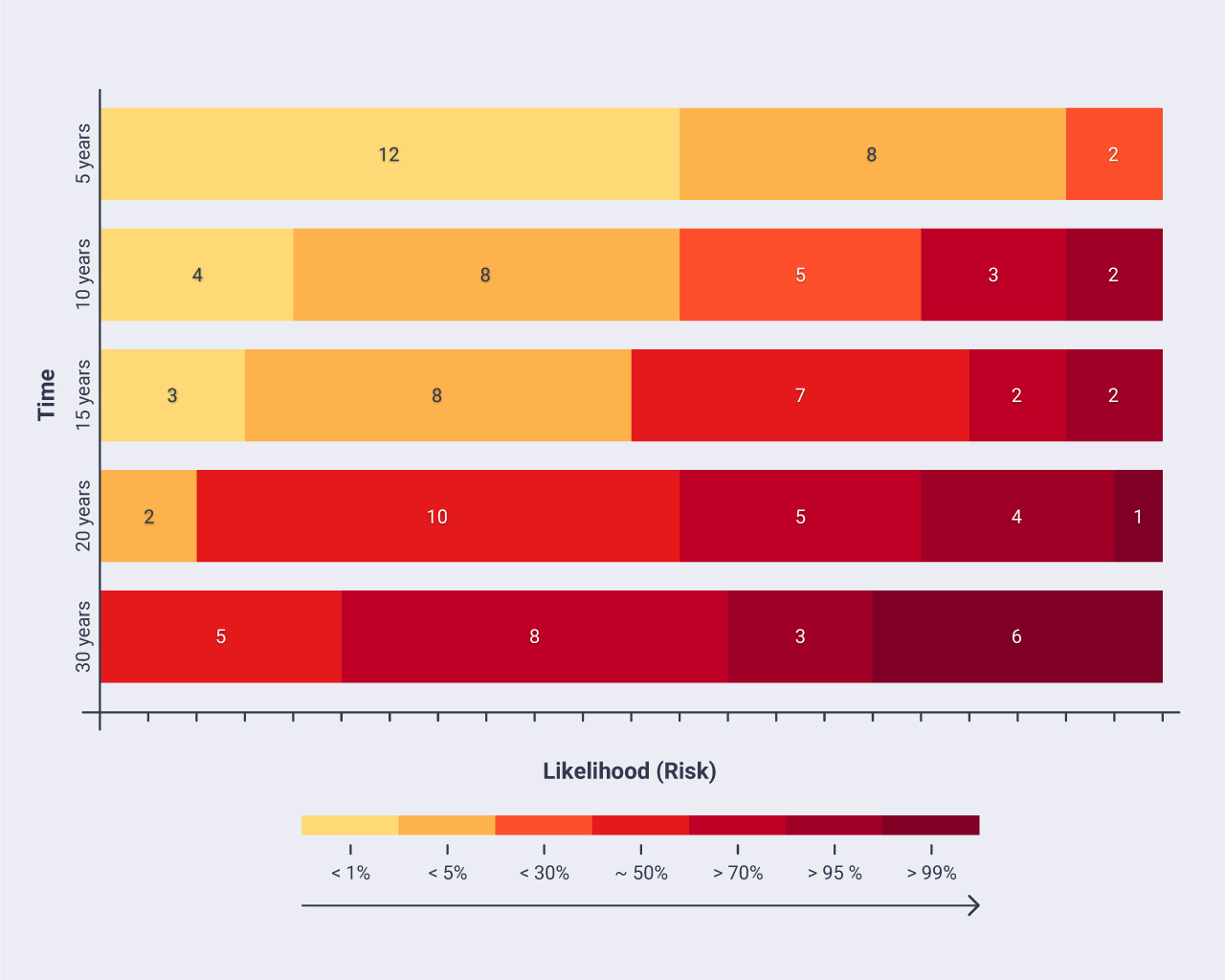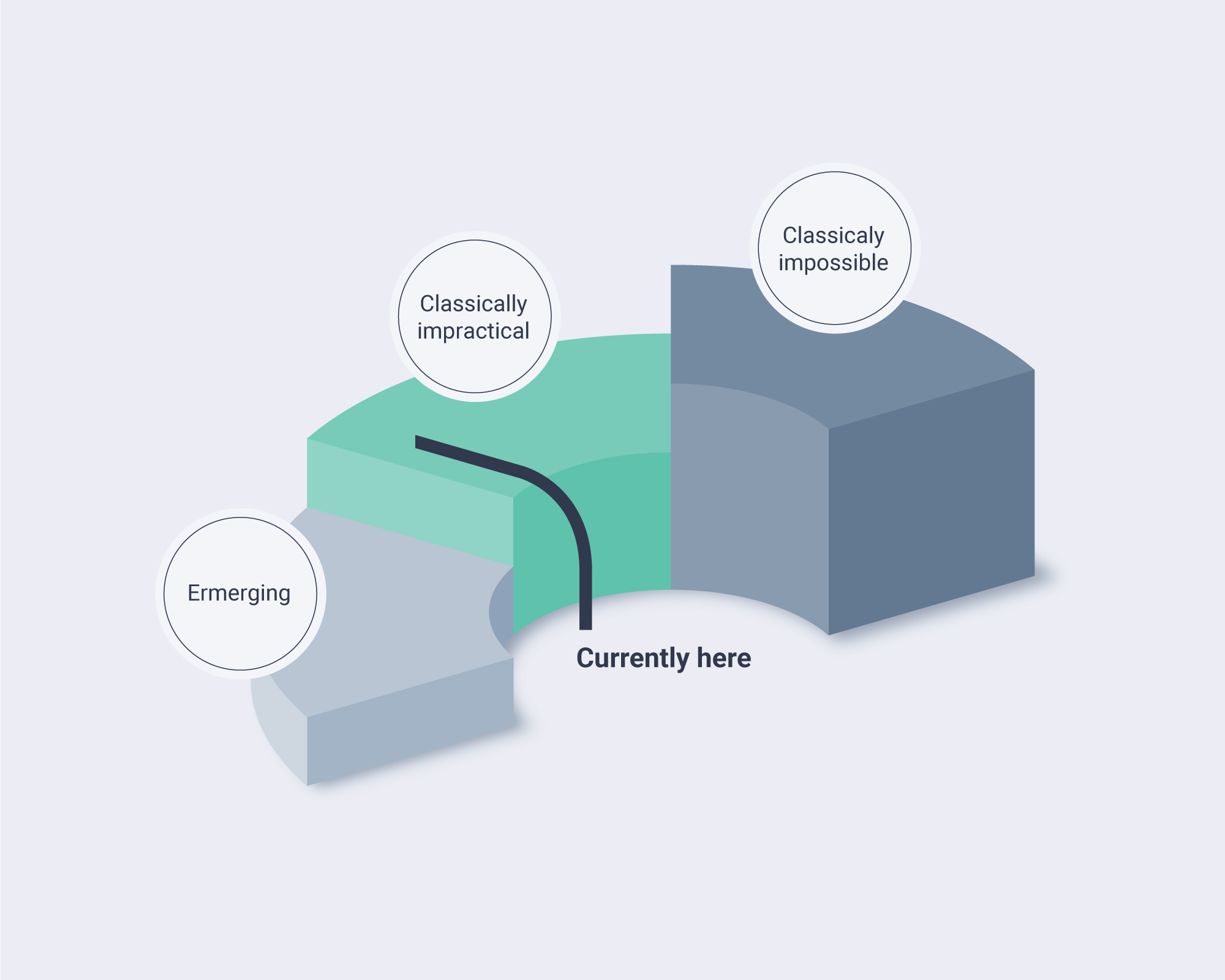This report aims to highlight the importance of quantum computing as a technology, to present its current development stage as well as its potential, and to give a general overview of key players in the field. However, it is important to note that though quantum computers are well established in research labs all around the world, they are still quite far away from fulfilling their true potential and being deployed in real-life scenarios. In order to get there, serious advances will need to take place on a technological level.
Paradigm shift and increased problem complexity
Paradigm shift and increased problem complexity
The world is undergoing constant economic, political, and social transformations, which give rise to new challenges. The latest scientific discoveries have begun to challenge old ontologies, leading to major shifts in terms of mentality and scientific views. The COVID-19 crisis has also proven how important and necessary technology is in all aspects of life, ranging from education to manufacturing, logistics, and healthcare.

Other major factors that influence the need for quantum computers include:
Globalization
Every industry has suppliers in different parts of the world and ships its products to numerous countries. Therefore, multiple factors are to be taken into consideration, from production constraints, access to resources, customer needs and demands, etc. Planning and finding optimum solutions in terms of cost and efficient use of resources, avoiding bottlenecks becomes essential.
Natural hazards
Disease outbreaks, geopolitical factors or other unexpected natural disasters can impact the way industries function at any time. Companies and governments need to respond fast, adjusting their working models accordingly and continuing their operations.
Technological progress
Digitalization, access to new technology and the high speed of advancements puts a lot of pressure on companies. Those who become capable of harnessing the benefits of new technologies also increase their chances to succeed through the optimization of their processes, cost savings and prompt reactions.
On the technological side, the overall trend is that components in traditional devices are constantly shrinking and the capabilities of the processors are rapidly increasing. Therefore, it is expected that they will soon be made out of only a handful of atoms,1 at which point it will be impossible for conventional devices to perform computations. At the same time, according to Moore’s Law, the number of transistors on a microprocessor doubles more or less each year while production costs decrease. However, this process has started to slow down and may even have stopped, meaning that improvements to conventional computers will reach an upper limit and that different ways of processing information need to be found if further technological advancements are desired.2 So far, the answer to these challenges has been to stack layers of transistors and to have multiple processes run in parallel, but this approach is limited by heat production and the signal-to-noise ratio at minute spacing intervals.
Nevertheless, quantum computers will not replace conventional devices by providing a faster and more advanced all-purpose solution. On the contrary, quantum devices will only target special problems, while most of the activities we currently perform with legacy systems will remain unaffected.
Until the beginning of this century, the science paradigm was based on Newtonian laws and was suitable mostly for describing phenomena at the macroscopic level (systems larger than one micron). However, new technological advancements have led scientists to discover a vast array of phenomena, mostly related to the microscopic world (e.g., atoms, elementary particles), that behave differently and do not follow the principles of classical physics. This has brought scientists to the conclusion that the only way science can advance is by implementing metaphysical postulates.3 These postulates remain at the basis of current experiments in the field of quantum technology and have led to the development of the first quantum computers.
Being “quantum ready”
Being “quantum ready”
As with many discoveries and innovations, the development of quantum computers was triggered by theoretical research and was based on challenges that scientists experimented in the field of physics and mathematics. In 1994, Peter Shor, a professor of Applied Mathematics at MIT, developed an algorithm for factoring exponential larger numbers, which could be performed significantly faster on a quantum computer than on a traditional one.
Even though quantum computers have not reached the level of development required to run such algorithms effectively, it is expected that soon this algorithm will be used to break most of the current public key encryption protocols.
This has resulted in the so-called “quantum threat,” a situation in which public and private organizations will be forced to rethink their data security systems or face losing clients and credibility due to security breaches and sensitive data loss.
Such real or potential security risks create pressure on businesses and governments alike to invest in understanding the implications of this technology and in developing quantum-risk management plans.
In 2015, the NSA (National Security Agency in US) declared that it was imperative to start preparing against the threat posed by the potential of quantum computers.5 One year later, the NIST (National Institute of Standards and Technology) initiated a process to gather and evaluate quantum-resistant public-key algorithms.6 The results of the third round of evaluations were published in July 2020 and it is expected that in 2022, the NIST will select the winning algorithms and publish the guidelines for their implementation.7

According to a study conducted in October 2019 by The Global Risk Institute and evolutionQ Inc., which surveyed 22 experts in the cryptography field, the general feeling is that the probability of the public-key cryptosystem being broken in the next five years is very narrow. This is mostly because quantum devices are still in the development phase and have not fulfilled their potential yet. However, when considering a timeframe of ten years, more scientists start to acknowledge the potential of a threat. Ninety percent of respondents stated that within 20 years, there was a more than 50 percent likelihood that the quantum threat would become a reality, while 17 out of 22 experts indicated that within 30 years, the threat has a more than 70 percent chance of materializing.8
Based on a complex prediction model developed by Sevilla and Riedel (2020), a proof of concept for a quantum computer sufficiently advanced to break the RSA-2048 encryption will be developed between early 2026 and early 2033, and RSA-2048 Shor attacks will become feasible between mid-2039 and mid-2058.9
Are we there yet?
Are we there yet?
There is a consensus that quantum computing is a radical innovation that will lead to the development of new technologies and give rise to new markets. At the same time, quantum computing can also be considered a disruptive innovation because it brings new technologies into existing markets, changing the way they operate (e.g., quantum computers have the potential to alter the process of drug development significantly). However, such impact predictions are currently still speculative, since technological advances have not reached the level required to have a significant impact on other industries.
Tony Uttley, president of Honeywell Quantum Solutions, has identified three stages (“eras”) in the development of quantum computing.10

The creation of quantum computers marks a significant breakthrough and the beginning of the “emergent era”. Scientists have gone from dealing with theoretical concepts and simulations to actually developing quantum algorithms and implementing them on quantum computers. This has created many opportunities for research and development, trial-and-error processes, and the introduction of new creative approaches. Using quantum algorithms on real quantum computers allows scientists to discover their limitations, push boundaries, and experiment with new things. The resulting improvements are highly visible, as are the areas that show promise and potential for investment.
We are currently moving towards the next stage, the “classically impractical era”. Currently, quantum algorithms are run on quantum computers, but the results are still reviewed on traditional devices. This validation process helps build trust in quantum technology and drives performance improvement. When this phase ends, there will be no possibility of checking the results of the quantum computation, so the know-how acquired in this period is paramount.
In this era, quantum computers can solve similar problems as conventional computers do. While this is possible and feasible, it is also inefficient due to costs, energy consumption, and the steep learning curve that could hinder the process. Problems have to be broken down to match the quantum computer’s incipient capabilities, but every advance in quantum technology increases the potential complexity of problems that can be solved.
However, this stage is absolutely necessary for companies that want to secure an advantage and be prepared for the moment when quantum computers scale up and can tackle the so-called intractable problems (which cannot be solved using traditional devices). By ensuring that the know-how, the technology, and the processes are available, companies will be ready to harness the benefits of fully functional quantum computers.
The “classically impossible era” starts when quantum computers become so advanced that the problems they can tackle and the results they produce cannot be tried and validated on a traditional device anymore. Even if this stage is not expected to be achieved in the near future, scientists, investors, business representatives, and governments are confident that the future results are worth the investment.
References
[1] M. Mitchell Waldrop, “The Chips Are down for Moore’s Law,” Nature News 530, no. 7589 (February 11, 2016): 144, https://doi.org/10.1038/530144a.
[2] Waldrop, “The Chips Are down for Moore’s Law,” 144.
[3] Hans Christian Öttinger, A Philosophical Approach to Quantum Field Theory (Cambridge, United Kingdom: Cambridge University Press, 2018).
[4] “Advantages of Quantum Cryptography | QuantumXC,” Quantum Xchange, 2020, https://quantumxc.com/applied-quantum-cryptography-old/.
[5] Tom Simonite, “NSA Says It ‘Must Act Now’ Against the Quantum Computing Threat,” MIT Technology Review, February 3, 2016, https://www.technologyreview.com/2016/02/03/162433/nsa-says-it-must-act-now-against-the-quantum-computing-threat/.
[6] Information Technology Laboratory Computer Security Division, “Post-Quantum Cryptography | CSRC,” CSRC | NIST, January 3, 2017, https://content.csrc.e1a.nist.gov/projects/post-quantum-cryptography.
[7] Jack Corrigan, “Don’t Rush Quantum-Proof Encryption, Warns NSA Research Director,” Nextgov.Com (blog), accessed October 19, 2020, https://www.nextgov.com/emerging-tech/2019/11/dont-rush-quantum-proof-encryption-warns-nsa-research-director/161217/.
[8] Michele Mosca and Marco Piani, “Quantum Threat Timeline,” Cyber Security and Fraud (Global Risk Institute, October 3, 2019), https://globalriskinstitute.org/publications/quantum-threat-timeline/.
[9] Jaime Sevilla and C. Jess Riedel, “Forecasting Timelines of Quantum Computing,” ArXiv:2009.05045 [Quant-Ph], September 10, 2020, http://arxiv.org/abs/2009.05045.
[10] Honeywell, Transforming Life Sciences with Quantum Computing, 2020, https://www.linkedin.com/video/live/urn:li:ugcPost:6694586275753680896/.